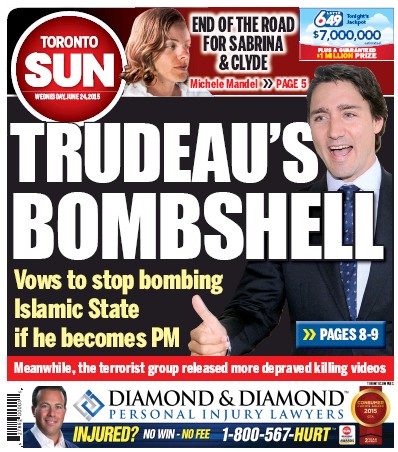SWOT is an analysis technique consultants use to assess internal STRENGTHS and WEAKNESSES – to a campaign, to a client, to a cause – and to evaluate external OPPORTUNITIES and THREATS.
A SWOT analysis isn’t about a message – it’s about a thing, or a factor, that can help or hurt. It can be happening right now, or is something likely to happen in the future.
The Canuckistan commentariat are pretty good at assessing the political import of things that have already taken place. But what about future events – things that haven’t happened yet? What is the political impact of those?
Herewith and hereupon, a SWOT analysis of ten things that may or may not happen over the next four months.
1. The weather: Hurricane Sandy helped return Barack Obama to the White House – remember that iconic shot of the president hugging a tearful New Jersey marina owner? – but extreme weather events can terminate political careers, as well. In era where climate change is both dramatic and undeniable, Prime Minister Stephen Harper has done rather well (cf. the floods in Calgary, Manitoba, Montérégie and so on). His opponents, meanwhile, tend to all but disappear during these disasters. Based on past events, a Conservative STRENGTH and OPPORTUNITY.
2. Terror: Sadly, acts of terror – whether committed by jihadists or neo-Nazis – have become a daily occurrence (globally) or a factor in daily life (domestically). The murders of Canadian Armed Forces members Nathan Cirillo and Patrice Vincent by jihadists just eight months ago had a profound effect on our politics. As was the case post-9/11, acts of terror propel the electorate into the arms of conservative political parties, as these players are seen as more credible on “law and order” themes. Another Conservative STRENGTH and OPPORTUNITY.
3. Length of writ: Pundit Guide’s Alice Funke has speculated that the Conservative government may well extend the writ period from the standard 37 days required under the Elections Act, and thereby increase their advertising budget along with it. With their demonstrated fundraising superiority, a super-sized writ would present yet another a Conservative Party OPPORTUNITY. But it could be a THREAT to them, as well: in the extended 2005-2006 campaign writ period, the incumbent Liberals bizarrely ran a 36-day campaign during a 55-day writ period – while the challenger Conservatives paced themselves, and ultimately triumphed. An extended writ period, therefore, could similarly present an OPPORTUNITY for the challenger NDP and Liberals.
4. Facebook, Twitter: In the modern era, social media have become a gold mine for political war rooms – and an ongoing headache for campaign management, and political leaders. Alberta’s 2012 election notwithstanding, social media-based flubs aren’t typically a game-changer – but they do have the potential to throw campaigns off-track for a day or two. For all of the parties, social media are therefore both an OPPORTUNITY and a THREAT.
5. Scandals: As you read this, Liberal Party operatives are poring through the emails and files of former Conservative Party strategist Dimitri Soudas, looking for dirt to fling during the writ period. Similarly, the Conservative Party are aware of sworn affidavits that have the potential to greatly damage Liberal leader Justin Trudeau’s reputation. If the muck starts to fly – in a kind of Tory-Grit mutually-assured-destruction exercise – it will provide New Democrats with a huge OPPORTUNITY to depict themselves as the only mainstream option not caked in grime.
6. Paid media: For a decade, the Conservatives have simply had much better ad campaigns – a STRENGTH – while Grits and Dippers have had a demonstrated paid-media WEAKNESS. Based on the recently-broadcast evidence, expect this dynamic to continue.
7. Media and money: As in, the former lack the latter. As such, media organizations lack the means to cover campaigns as they did in days of old – and so they now tend to favour following only those campaigns who have a realistic shot at winning. If the Liberal Party continues its precipitous slide in public opinion polls, media inattention may well be the result – and is a huge THREAT, and a similarly-sized NDP OPPORTUNITY.
8. Leaders debates: The Conservative Party has successfully – and brilliantly – ensured that the various leader’s debates will be very difficult for regular folks to see. For the best debater on the stage, Tom Mulcair, this is a real problem and therefore a THREAT: he needs the debates to convince Canadians that he isn’t a wild-eyed radical. Similarly, for Trudeau, the debates – while a potential WEAKNESS, given some of Trudeau’s past verbal mishaps – are now keenly needed to get back in the game. All told, a Conservative STRENGTH.
9. Third party campaigns: Most recently, Engage Canada has taken to the airwaves with a potent anti-Harper message (a THREAT for him) – but also no clearly-expressed alternative. Does it favour Mulcair or Trudeau? We can’t tell. As such, Engage – and progressive campaigns like it – may end up creating an OPPORTUNITY for Harper, because they equalize and split the Conservative leader’s progressive opposition.
10. The teams: By now, most political folks recognize that Trudeau’s core team has become a liability – they have angered the Grit rank and file on myriad issues, and they arrogantly assumed Trudeau’s popularity would have no end: WEAKNESS. The Conservative campaign is no longer led by Doug Finley, as it was until 2008 – but Jenni Byrne ably demonstrated in 2011 that she knew how to win a majority: a STRENGTH. The NDP, meanwhile, have brought back Jack Layton whiz kids Brad Lavigne and Anne McGrath – this, too, testifies to New Democrat bench STRENGTH.
You can do the SWOT, too, and come up with different results. For this writer, however, the yet-to-happen tends to yield Conservative and/or New Democrat STRENGTHS and OPPORTUNITIES.
Team Trudeau, meanwhile, are beset by more than their fair share of WEAKNESSES and THREATS.
The only question, to me, is this: what on the above list is actually going to happen?
Comments (39)





